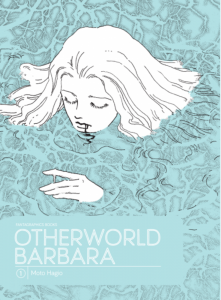By Moto Hagio | Published by Fantagraphics
 It’s 2052 and Tokio Watarai, a dream pilot, is coming home to Japan for the first time in three years. Although his ex-wife and son are in Japan, he’s actually returning for a job involving a girl who’s been sleeping for seven years since being found with her parents’ hearts in her stomach. Her name is Aoba, and when Tokio enters her dream it’s all about an island called Barbara in which kids can fly and cannibalism factors in to funeral rites. Soon, he learns that his son, Kiriya, actually invented Barbara. So how is Aoba able to dream about it?
It’s 2052 and Tokio Watarai, a dream pilot, is coming home to Japan for the first time in three years. Although his ex-wife and son are in Japan, he’s actually returning for a job involving a girl who’s been sleeping for seven years since being found with her parents’ hearts in her stomach. Her name is Aoba, and when Tokio enters her dream it’s all about an island called Barbara in which kids can fly and cannibalism factors in to funeral rites. Soon, he learns that his son, Kiriya, actually invented Barbara. So how is Aoba able to dream about it?
That introductory paragraph actually simplifies the story greatly. There’s also Tokio’s horrid ex-wife Akemi and the creepy priest Johannes whom she loves and who could possibly be Aoba’s grandfather but also head of an American orphanage in which cloned children were created, including one called Paris who comes to Japan and believes Kiriya might be a boy he knew called Taka. There’s Kiriya’s massive angst, his dreams of Mars, his dream conversations with Aoba, the girl Laika who fancies him, a psychiatrist who treated Aoba who is killed by a tornado she created, his identity-swapping and cross-dressing fraternal twin children, anti-aging research (potentially conducted upon the residents of Barbara) including a suit that turns Aoba’s grandma into a young woman who calls herself Marienbad and has a fling with Tokio, Daikoku’s ominous hinting that Kiriya will kill Tokio someday, parental regrets, etc.
 By the end of the first volume, so very many plot threads are in the air that I was not at all sure that Hagio-sensei would be able to make everything make sense in the end. To use just one example: If Barbara is just a dream—and, indeed, no such island actually exists—then how is it possible that the blood of its residents is used for anti-aging medicine? And yet we see evidence that such advances are already in the works. And because of all this plot stuff, there’s not a lot of time for building solid relationships. There is angst aplenty, especially courtesy of Kiriya, but the whole Marienbad/Tokio hookup, for example, is just extremely random. The strongest bond, though, is definitely the love Tokio feels for his son and his regret over having been a crappy father.
By the end of the first volume, so very many plot threads are in the air that I was not at all sure that Hagio-sensei would be able to make everything make sense in the end. To use just one example: If Barbara is just a dream—and, indeed, no such island actually exists—then how is it possible that the blood of its residents is used for anti-aging medicine? And yet we see evidence that such advances are already in the works. And because of all this plot stuff, there’s not a lot of time for building solid relationships. There is angst aplenty, especially courtesy of Kiriya, but the whole Marienbad/Tokio hookup, for example, is just extremely random. The strongest bond, though, is definitely the love Tokio feels for his son and his regret over having been a crappy father.
Happily, the second volume does make with the answers, starting almost immediately. Not everything is answered with absolute certainty—one particular narrative thread takes a completely unexpected and surprisingly poignant turn. Even 90% of the way through, I would’ve said there was no way Otherworld Barbara would be able to make me cry, and yet it did. I won’t reveal how, but I loved the devastating consequences of a desperate act on Tokio’s part, and how it led him to have faith that Aoba’s dream of Barbara really could be shaping a vision of the future. That ending makes everything else worthwhile. Too, I enjoyed the contrast between Hagio’s uncomplicated, light-filled artwork and the dark and weird story she told.
Ultimately, Otherworld Barbara is definitely worth reading. Thank you, Fantagraphics, for releasing it!
Otherworld Barbara is complete in two 2-in-1 editions.
Review copies provided by the publisher






Recent Comments